If you missed my first build, you can find it here:
http://www.diyaudio.com/forums/planars-exotics/199519-some-more-questions-els-design.html
After completing these speakers, which I absolutely love, I decided to build a pair of sub woofers, each with dual 15" Tempest -X drivers. Well, the woofers turned out great as well. Unfortunately, they take up too much space in the AV room and one of them had to be stuffed into a corner. Acoustically, not a problem, but visually, not to my liking. Here are a couple of pictures which explain my displeasure:


Notice the sub in the corner on the left.
So I have decided to build a new set of electrostatic speakers that are narrower than the ones in the pictures above. The new ones are 10 inches narrower, so the extra 20" will give me the room I need to get the left sub woofer back into the listening area. Here's a picture of the new speakers:
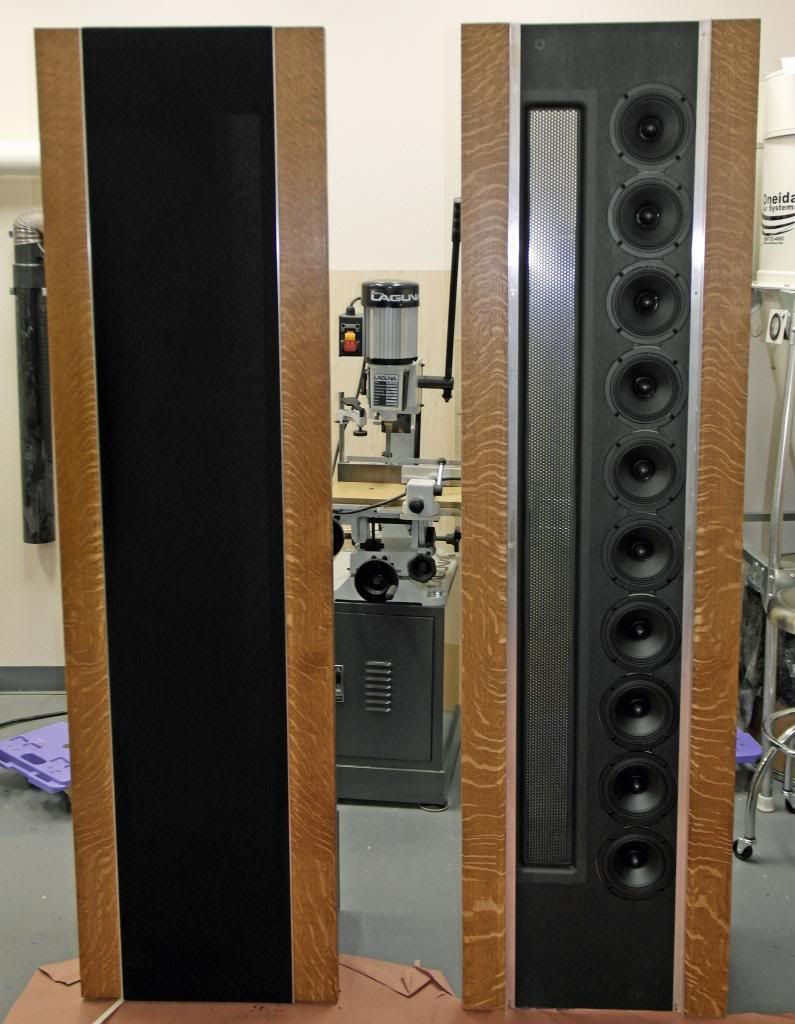
Once again I used quarter sawn white oak and the sides are book matched. Also I added an aluminum trim separating the wood from the grill cloth. The speakers aren't completed yet as I have to wire everything up. As before, they will be bi-amp'd with the ELS panels handling the frequencies above 600 Hz. After I get them up and running I'll post some more information.
http://www.diyaudio.com/forums/planars-exotics/199519-some-more-questions-els-design.html
After completing these speakers, which I absolutely love, I decided to build a pair of sub woofers, each with dual 15" Tempest -X drivers. Well, the woofers turned out great as well. Unfortunately, they take up too much space in the AV room and one of them had to be stuffed into a corner. Acoustically, not a problem, but visually, not to my liking. Here are a couple of pictures which explain my displeasure:


Notice the sub in the corner on the left.
So I have decided to build a new set of electrostatic speakers that are narrower than the ones in the pictures above. The new ones are 10 inches narrower, so the extra 20" will give me the room I need to get the left sub woofer back into the listening area. Here's a picture of the new speakers:

Once again I used quarter sawn white oak and the sides are book matched. Also I added an aluminum trim separating the wood from the grill cloth. The speakers aren't completed yet as I have to wire everything up. As before, they will be bi-amp'd with the ELS panels handling the frequencies above 600 Hz. After I get them up and running I'll post some more information.
Excellent!!!!
Do let us know how they turnout!!!
I have been thinking about this same type of format for my room using some High excursion 8" subs from MCM.
My room is only 10.5' wide on the speaker end and leaves very little room for some panels with my current woofer system.
How wide is the ESL element?
I have learned that the wavefront starts to transition from the Figure 8 pattern into focused beams when the width of the driver equals one wavelength.
And also transitions from the figure 8 pattern to a circular omni directional pattern at lower frequency's equaling one wavelength of the width of the driver.
The Baffle does have some effect on this as well.
Great Work!!!!!
jer
Do let us know how they turnout!!!
I have been thinking about this same type of format for my room using some High excursion 8" subs from MCM.
My room is only 10.5' wide on the speaker end and leaves very little room for some panels with my current woofer system.
How wide is the ESL element?
I have learned that the wavefront starts to transition from the Figure 8 pattern into focused beams when the width of the driver equals one wavelength.
And also transitions from the figure 8 pattern to a circular omni directional pattern at lower frequency's equaling one wavelength of the width of the driver.
The Baffle does have some effect on this as well.
Great Work!!!!!
jer
Last edited:
Hi,
another fine looking Entity of Superior Electrostatic Loudspeaking
just some Q and remarks.
Are the midwoofers dipoles too or encased in a CB?
What were the reasons to xover at 600Hz, not lower?
Do You get any issues of the midwoofers blowing the membrane into the stators? If so a slot in the front panel between ESL and woofers could help.
Like the fixture of the Oak stripes with the aluminum brackets used as optical stylish element at the same.
jauu
Calvin
another fine looking Entity of Superior Electrostatic Loudspeaking
just some Q and remarks.
Are the midwoofers dipoles too or encased in a CB?
What were the reasons to xover at 600Hz, not lower?
Do You get any issues of the midwoofers blowing the membrane into the stators? If so a slot in the front panel between ESL and woofers could help.
Like the fixture of the Oak stripes with the aluminum brackets used as optical stylish element at the same.
jauu
Calvin
Hello fperra,
Once again you are showing off your woodworking and building skills
I would second Calvin's concern about the woofers "blowing" the ESL membrane into the stators. I experienced this when building a similar project. As Calvin already mentioned, the solution is to separate the ESL and the woofer panels by a slot. You may also need to add a rearward projecting baffle on the woofer side to further isolate the ESL from the dipole woofer's air motion. If see-thru optics are not required, adding some resistive damping on the rear stator with silk screen mesh or thin felt will also help considerably with the problem of acoustic coupling with the woofer.
You don't have to get your ESL going to get a feel for the magnitude of the problem.
Just wire up your woofers and do a frequency sweep or listen to some bass heavy music and see if the diaphragm hits the stators.
Once again you are showing off your woodworking and building skills

I would second Calvin's concern about the woofers "blowing" the ESL membrane into the stators. I experienced this when building a similar project. As Calvin already mentioned, the solution is to separate the ESL and the woofer panels by a slot. You may also need to add a rearward projecting baffle on the woofer side to further isolate the ESL from the dipole woofer's air motion. If see-thru optics are not required, adding some resistive damping on the rear stator with silk screen mesh or thin felt will also help considerably with the problem of acoustic coupling with the woofer.
You don't have to get your ESL going to get a feel for the magnitude of the problem.
Just wire up your woofers and do a frequency sweep or listen to some bass heavy music and see if the diaphragm hits the stators.
Thanks for all the positive comments. Here is some more information and pictures on the build. The cone speakers are TB W5-704D of which there are 10 per speaker. They are mounted in a vented box tuned to 50 Hz, but they will be crossed over to the sub woofers at 80 Hz. The els panel is the same design as my previous build; it's dimensions are 5-1/2" x 6--1/2" with the radiating area 3-1/2" x 58-1/2". I'll be experimenting with the crossover frequency, searching for the sweet spot somewhere between 400 to 800 Hz. As before I'll be using a digital crossover unit that is a Chinese clone of the Ashly Protea 4.8SP 4x8 Processor. This unit is much quieter than the DCX2496 and easier to program.
Some more pictures:
The power supply
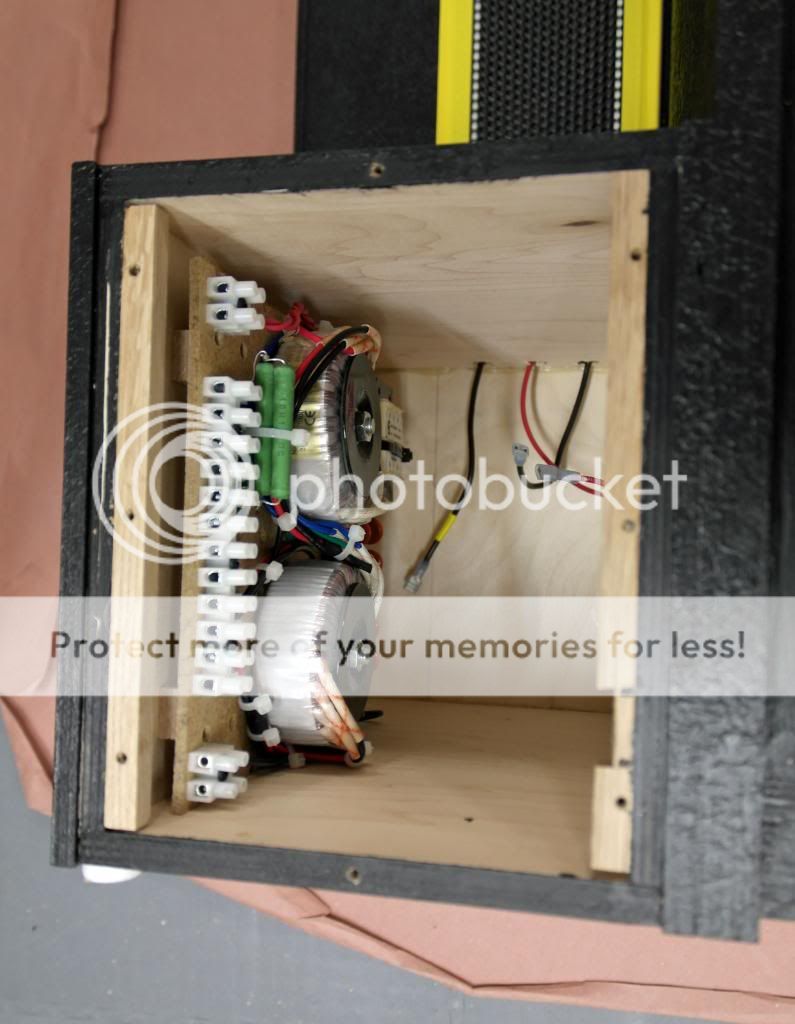
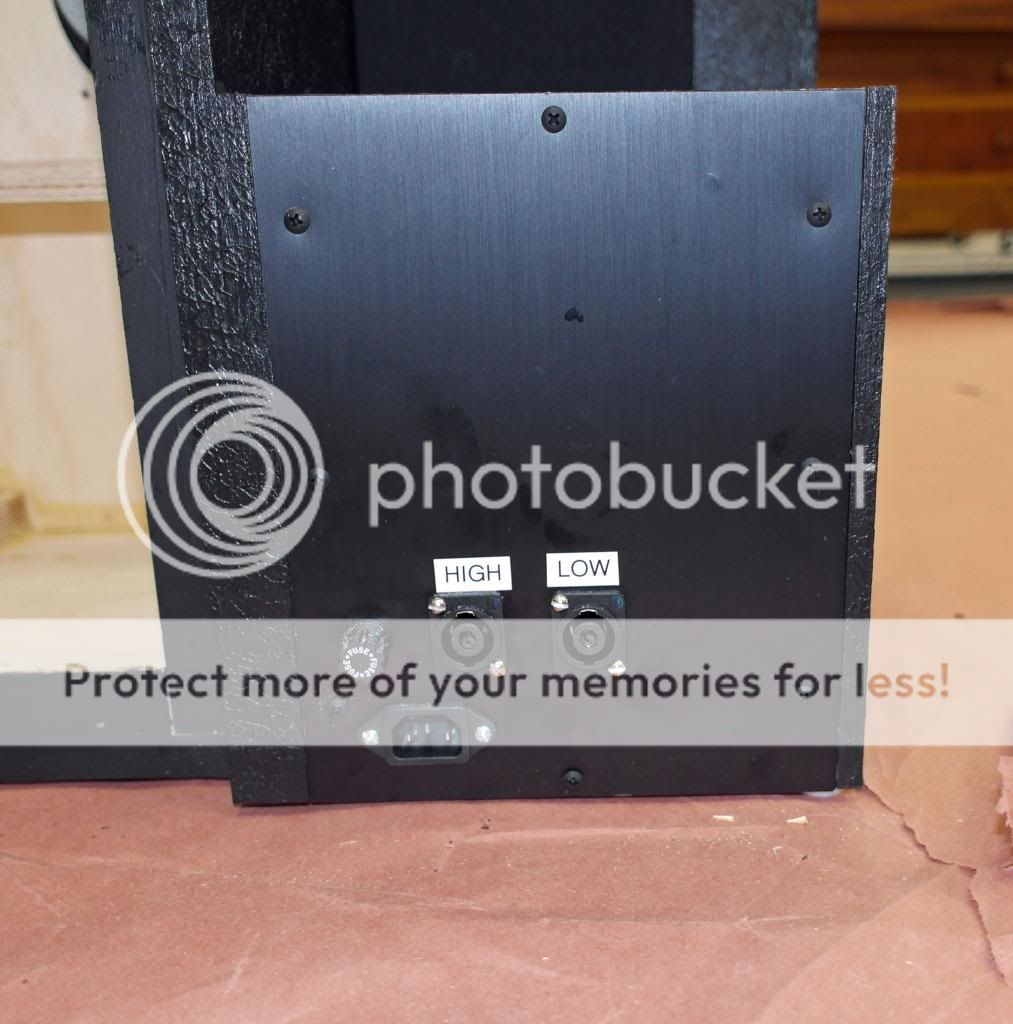
Rear grill cover for the ELS. I made it deep enough so I can experiment with damping material. Also notice the rear of the cabinet is finished with Duratex paint. I love that stuff.
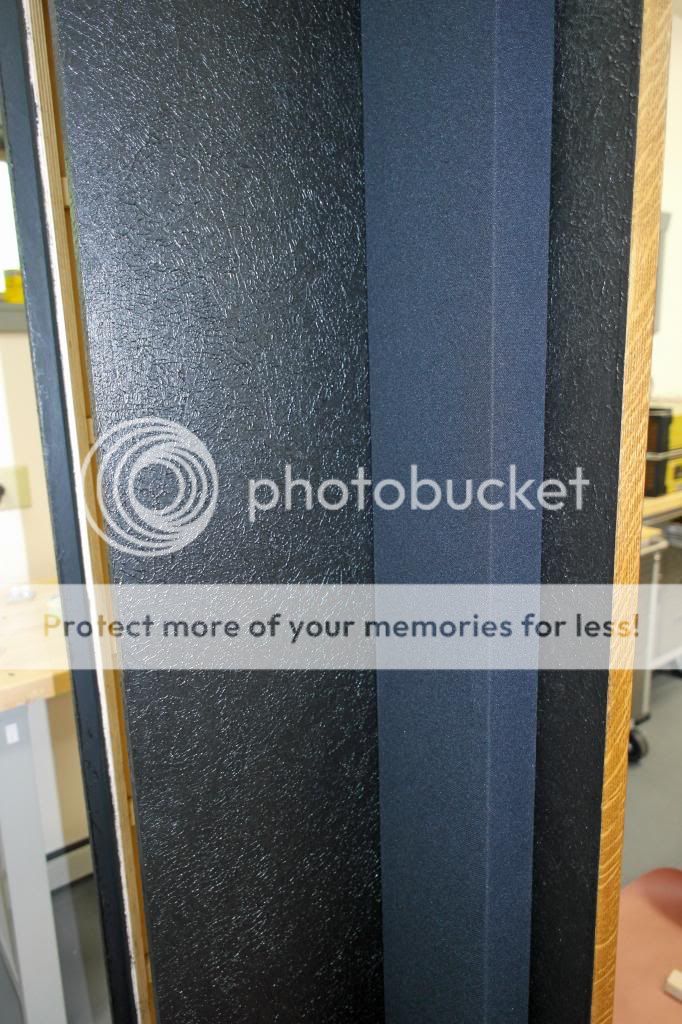
Inside view of the speaker box. 4cf. I'm wating for some parts from Parts Express to finish them off.
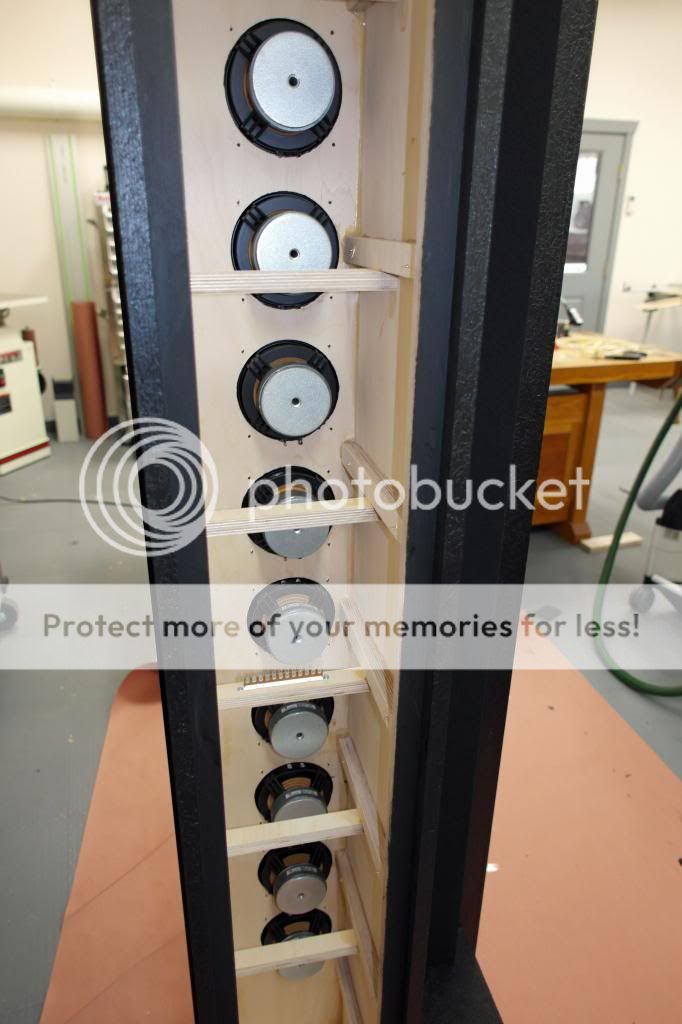
A close up view of the book matched columns. I have a large supply of quarter sawn white oak raw lumber that I use to make Stickley style furniture. I made some 1/16" veneer from one board, so both speakers have book matched columns and the left and right speakers match each other.
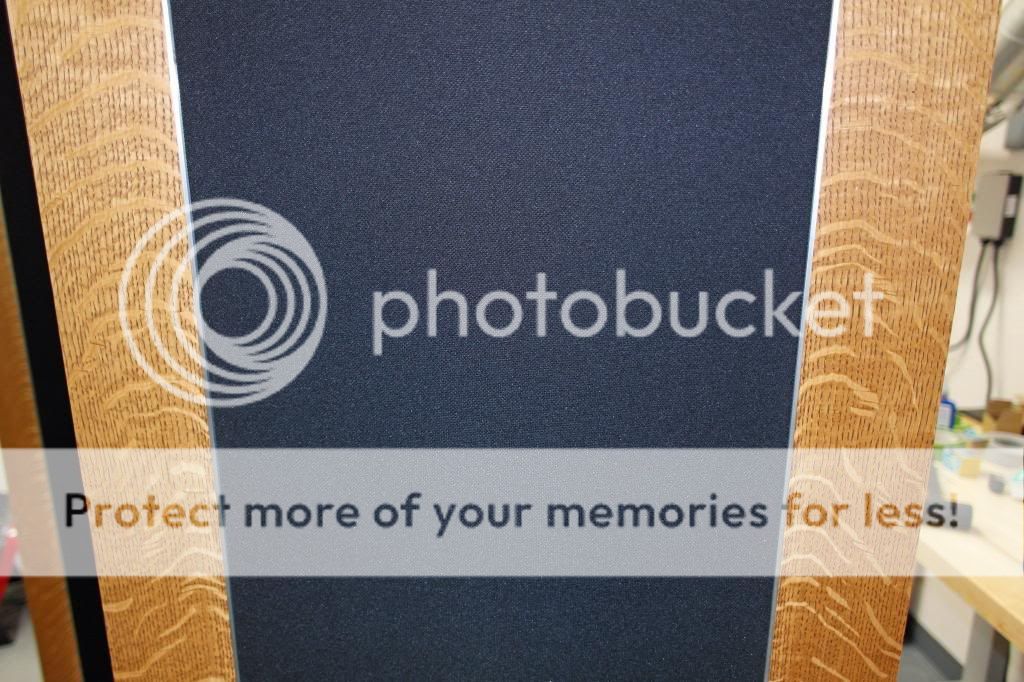
That's about it for now.
Some more pictures:
The power supply


Rear grill cover for the ELS. I made it deep enough so I can experiment with damping material. Also notice the rear of the cabinet is finished with Duratex paint. I love that stuff.

Inside view of the speaker box. 4cf. I'm wating for some parts from Parts Express to finish them off.

A close up view of the book matched columns. I have a large supply of quarter sawn white oak raw lumber that I use to make Stickley style furniture. I made some 1/16" veneer from one board, so both speakers have book matched columns and the left and right speakers match each other.

That's about it for now.
Fperra:
Are the toroids from Antek? If not, what are you using? Thanks.
Yes.
Hello fperra,
Once again you are showing off your woodworking and building skills
I would second Calvin's concern about the woofers "blowing" the ESL membrane into the stators. I experienced this when building a similar project. As Calvin already mentioned, the solution is to separate the ESL and the woofer panels by a slot. You may also need to add a rearward projecting baffle on the woofer side to further isolate the ESL from the dipole woofer's air motion. If see-thru optics are not required, adding some resistive damping on the rear stator with silk screen mesh or thin felt will also help considerably with the problem of acoustic coupling with the woofer.
You don't have to get your ESL going to get a feel for the magnitude of the problem.
Just wire up your woofers and do a frequency sweep or listen to some bass heavy music and see if the diaphragm hits the stators.
I finally finished the speakers and have them hooked up in the garage for testing. The first thing I did was testing to see if the dynamic speakers would cause the the diaphragms to hit the stators. I ran sheeps from 80 Hz to 600 Hz and there was no impact on the ELS. So that doesn't look to be a problem. The dynamic drivers have about 12 db move sensitivity than the ELS panels so I may double up on the toroidal transformers. I really don't have to since I have gobs of amplifier power and the electronic crossover can adjust for the efficiency difference. I'm quite happy with the sound as there is very little difference between the new ones and my first build.
I finally finished the speakers and have them hooked up in the garage for testing. The first thing I did was testing to see if the dynamic speakers would cause the the diaphragms to hit the stators. I ran sheeps from 80 Hz to 600 Hz and there was no impact on the ELS. So that doesn't look to be a problem.
That is good news. My comments were based on the assumption that your woofers were being run dipole (ie open back). Since the woofers are enclosed, there is much less concern for acoustic coupling driving the ESL diaphragm into the stators.
You should still be able to easily identify the diaphragm resonance be placing an ear near the ESL panel while sweeping down in frequency(200hz to 20Hz) on the woofers. You will hear a noticeable increase in output at the diaphragm resonance, and if looking at reflections from the diaphragm you will see them "dancing". With enclosed woofers, this is usually the only frequency of concern.
- Status
- This old topic is closed. If you want to reopen this topic, contact a moderator using the "Report Post" button.
- Home
- Loudspeakers
- Planars & Exotics
- My Second ELS Build.